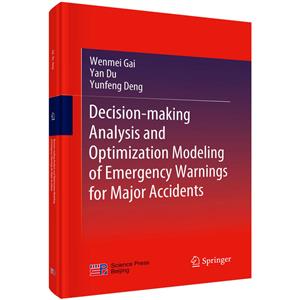重大事故紧急预警决策的分析和优化模式(英文版)
内容简介
[
本书从应急决策与优化的角度研究重大事故的预警决策问题,使读者了解应急预警决策理论及优化方法。基于人体脆弱性、风险评价、信息传播以及多目标优化等理论及方法,针对重大事故先兆性不明显等特点,书中针对重大事故的应急预警决策问题进行分析、建模并设计适合应急决策特点的模型算法,在定量评估疏散风险和分析应急预警信息传播规律的基础上,提出分户预警通知传播模型,预警通知系统部署决策与优化模型,疏散预警通知的决策与优化模型等重大事故应急预警决策方法,并以案例或模拟的形式对所建模型进行验证
]
目录
Contents1 Introduction 11.1 Background 11.2 What Is Emergency Warning 31.3 Leakage Accidents and Regional Evacuation in China 51.3.1 The Regional Distribution of Toxic Gas Leakage Resulting in Evacuation 51.3.2 Statistical Analysis of Evacuation Events 61.4 Public Protection Methods 91.4.1 The Basic Process of Emergency Evacuation 91.4.2 Safety Requirement for Personnel Evacuation for Toxic Gas Leakage 121.4.3 Determining Method of Evacuation Area 151.5 Evacuation Scale Estimation 181.5.1 Population Scale Estimation Methods 181.5.2 The Influence Factors on the Scale of Evacuation 211.6 Research Status of Emergency Decisions Both at Home and Abroad 221.7 Research Objects and Characteristics 26References 272 Emergency Warning System for Major Accidents 312.1 Emergency Warning System 312.1.1 Composition of the Early Warning System 312.1.2 Functions of Early Warning System 322.1.3 Implementation of Early Warning System 342.2 Literature Review on References of Emergency Early Warning Both at Home and Abroad 362.2.1 Public Alerting System in the United States 362.2.2 The Public Alerting System in Japan 382.2.3 Public Alert System from Other Foreign Organizations 402.2.4 Public Alerting System in China 412.3 The Design and Implementation of Early Warning System for Major Accidents 432.3.1 FM Broadcasting Technology Based on Different Locations 432.3.2 The Structure of Public Alert System Based on FM Broadcast for Different Addresses 462.3.3 Researches on Hardware Development of Indoor Alarm Receivers 492.3.4 Researches on Embedded Software Development of Indoor Alarm Receivers 542.4 Summary of the Chapter 63References 633 Communication and Diffusion of Emergency Warning 653.1 An Overview of Researches on Communication and Diffusion of Emergency Warning 653.2 The Influence Factors of Early Warning Communication 673.3 General Rules for Alert Information Communication 713.4 Modeling of the Communication Rules of Alert for Individual Household 743.4.1 The Establishment of the Model 743.4.2 The Solution of the Model 773.5 The Simulation and Results Analysis of Communication Model of Alerts for Individual Household 793.5.1 Simulation Results and Analysis of the Communication Time 803.5.2 The Simulation Results and Analysis of Closeness of Social Relationship 813.5.3 Simulation Analysis and Results of Deployment Proportion of Alert Receivers 833.6 Summary of the Chapter 83References 854 Regional Evacuation Modeling for Toxic Cloud Releases and Its Application in Strategy Assessment of Evacuation Warning 894.1 Methods 904.1.1 Description of Regional Evacuation Network 904.1.2 Diffusion of Evacuation Warning 904.1.3 Loading of Evacuation Flow 944.1.4 Movement Through Regional Evacuation Network 954.2 Health Consequence Analysis 994.2.1 Accident Consequence Simulation 994.2.2 Exposure Dose Calculation 994.2.3 Conditional Probability of Consequences 1004.3 Case Study and Discussion in China 1004.3.1 Preliminaries 1004.3.2 Evacuation Efficiency Under Different Evacuation Warning Strategies 1034.3.3 Health Consequences of Accidents Under Different Evacuation Warning Strategies 1074.4 Summary of the Chapter 108References 1095 Multi-objective Route Planning Model and Algorithm for Emergency Management 1135.1 Literature Review 1135.2 Route Planning Model for Emergency Logistics Management 1165.2.1 Definition of Variables and Parameters 1165.2.2 Bounded Rationality in Decision-Making 1175.2.3 Multi-objective Route Planning Model for Emergency Logistics Management 1175.3 Preliminaries 1185.3.1 Classical Algorithms to Solve Single-Objective Shortest Path Problem 1185.3.2 Construction of Auxiliary Functions 1195.3.3 Main-Objective Method to Deal with Multi-objective Optimization Problems 1215.4 Proposed Heuristic Algorithm 1225.4.1 Static Heuristic Algorithm to Solve Model I Based on A* Algorithm 1235.4.2 Dynamic Heuristic Algorithm to Solve Model I Based on D* Algorithm 1245.4.3 Algorithm Advantage 1245.5 Computational Experiments 1255.5.1 Results of Model III When s Varies Within the Interval [0, 1] 1255.5.2 Results of Model I in Static Environments 1265.5.3 Results of Model I in Dynamic Environments 1475.6 Summary of the Chapter 148References 1496 Evacuation Risk Assessment of Regional Evacuation for Major Accidents and Its Application in Emergency Planning 1516.1 Evacuation Risk Assessment Process 1546.1.1 Calculation of Received Dose 1546.1.2 Conditional Probability Calculation of Health Consequence 1586.1.3 Determination of Occurrence Probability 1586.1.4 Calculation of Individual Evacuation Risk 1586.1.5 Acceptable Risk Level 1596.2 The Application in Emergency Planning 161
封面

书名:重大事故紧急预警决策的分析和优化模式(英文版)
作者:盖文妹,杜淼,邓云峰
页数:180
定价:¥198.0
出版社:科学出版社
出版日期:2018-12-01
ISBN:9787030593467
PDF电子书大小:76MB
